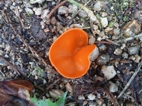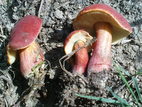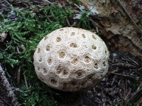Difference between revisions of "IBF Fungi"
| (42 intermediate revisions by 6 users not shown) | |||
| Line 1: | Line 1: | ||
| − | The | + | The current diversity of fungi, i.e., mainly macrofungi, in three natural areas around Regensburg will be monitored during 50 surveys within two years. The areas are a) the Otterbach valley near Altenthann; b) the nature reserve "Sippenauer Moor", a calcareous and sulphuric fen near Saal a.d. Donau; c) the calcareous dry grasslands of the "Alpiner Steig" between Eilsbrunn and Schönhofen. They belong to three of the [http://www.bayernflora.de/de/export/FlorenregionenK.jpg eight floristic regions of Bavaria] (S = Spessart-Rhön, P = Mainfränkische Platten, K = Keuper-Lias-Land, J = Fränkisch-Schwäbische Alb (Jura), O = Ostbayerisches Grenzgebirge, H = Molassehügelland, M = Moränengürtel, A = Alpen), i. e. to J, O and H. Detailed information on the occurrence of vascular plants, bryophytes, lichens and fungi are already available for these areas due to long-time floristic investigations there. The observation data gained in 2009 and 2010 will be compared with the historical data. They will give hints for changes in species diversity, and provide more information about exact localisations and abundance of the organisms observed. Furthermore, the data will be analysed according to ecological factors derived from [http://www.pilzoek.de/ PILZOEK]. |
| − | Major scientific goal of these investigations is to generate ecological profiles for the observed | + | Major scientific goal of these investigations is to generate ecological profiles for the observed taxa based on the vegetation units, habitats and substrate types on which they occur. The monitoring of fungi in the Otterbach valley near Altenthann and in the calcareous dry grasslands of the "Alpiner Steig" between Eilsbrunn and Schönhofen is carried out in parallel with the monitoring of lichens ([[IBF Lichens]]). |
| − | Scientists in this workpackage: Prof. Dr. A. Bresinsky | + | GBIF Data Resource [http://www.gbif.org/dataset/7ba0e7fa-f762-11e1-a439-00145eb45e9a IBF Monitoring of Fungi] |
| − | [ | + | |
| + | |||
| + | |||
| + | Scientists in this workpackage: J. Simmel, Prof. Dr. A. Bresinsky (the latter until 2011) | ||
| + | |||
| + | The DFG funded project IBF expired in 2014. | ||
| + | |||
| + | [http://www.uni-regensburg.de/biologie-vorklinische-medizin/fakultaet/index.html Ecology/Biology, University of Regensburg] | ||
| + | |||
| + | |||
| + | <gallery mode="packed"> | ||
| + | File:Fungi_1b.jpg|'Aleuria aurantia' | ||
| + | File:Fungi_3.JPG|'Xerocomus rubellus' | ||
| + | File:Fungi_2b.jpg|'Scleroderma citrinum' | ||
| + | </gallery> | ||
| + | |||
| + | |||
| + | Simmel, J. 2012 ("2011"). IBF Fungi – Großpilz-Kartierung mit Smartphone und GPS. Ein Beispiel aus dem Raum Regensburg. – Hoppea, Denkschr. Regensb. Bot. Ges. 72: 139–170. | ||
| + | |||
| + | |||
| + | *''' Overview table''', [[IBF Datasets accessible by GBIF|IBF Datasets accessible by GBIF and other portals]] | ||
| + | |||
| + | ---- | ||
[[IBF Fungi - Internal Sites ]] | [[IBF Fungi - Internal Sites ]] | ||
Latest revision as of 17:38, 21 November 2020
The current diversity of fungi, i.e., mainly macrofungi, in three natural areas around Regensburg will be monitored during 50 surveys within two years. The areas are a) the Otterbach valley near Altenthann; b) the nature reserve "Sippenauer Moor", a calcareous and sulphuric fen near Saal a.d. Donau; c) the calcareous dry grasslands of the "Alpiner Steig" between Eilsbrunn and Schönhofen. They belong to three of the eight floristic regions of Bavaria (S = Spessart-Rhön, P = Mainfränkische Platten, K = Keuper-Lias-Land, J = Fränkisch-Schwäbische Alb (Jura), O = Ostbayerisches Grenzgebirge, H = Molassehügelland, M = Moränengürtel, A = Alpen), i. e. to J, O and H. Detailed information on the occurrence of vascular plants, bryophytes, lichens and fungi are already available for these areas due to long-time floristic investigations there. The observation data gained in 2009 and 2010 will be compared with the historical data. They will give hints for changes in species diversity, and provide more information about exact localisations and abundance of the organisms observed. Furthermore, the data will be analysed according to ecological factors derived from PILZOEK. Major scientific goal of these investigations is to generate ecological profiles for the observed taxa based on the vegetation units, habitats and substrate types on which they occur. The monitoring of fungi in the Otterbach valley near Altenthann and in the calcareous dry grasslands of the "Alpiner Steig" between Eilsbrunn and Schönhofen is carried out in parallel with the monitoring of lichens (IBF Lichens).
GBIF Data Resource IBF Monitoring of Fungi
Scientists in this workpackage: J. Simmel, Prof. Dr. A. Bresinsky (the latter until 2011)
The DFG funded project IBF expired in 2014.
Ecology/Biology, University of Regensburg
Simmel, J. 2012 ("2011"). IBF Fungi – Großpilz-Kartierung mit Smartphone und GPS. Ein Beispiel aus dem Raum Regensburg. – Hoppea, Denkschr. Regensb. Bot. Ges. 72: 139–170.
- Overview table, IBF Datasets accessible by GBIF and other portals


